How to drive traffic to your website by optimizing product images
Image optimization is about reducing the file size of your images without sacrificing quality so that the loading time of your website is as fast as possible.
In the age of e-commerce, every online store needs to focus on image optimization, either to reduce page load time or to get your product images to rank on Google and other image search engines.
As a result of new technologies and updates to search engine algorithms, images are now a focal point to any effective SEO strategy and image optimization should be a top priority for any marketer, particularly marketers looking to convert visitors to buyers on their website.
Images that aren’t optimized can negatively affect site performance, and therefore, if you want to improve your conversion rate and your client engagement, you need to start paying more attention to your images, whether we are talking about descriptive photos displayed on the site or product images.
If your site isn’t loading as quickly as possible, you could be losing out on sales and be penalized by search engines.
Here are some tips that will help you optimize your product images and drive more traffic to your website.
Step 1: Save your image in the correct format
Three common file types are used to post images to the web: JPEG, GIF, and PNG.
GIF files are the only format available that supports animation, are lower in quality, but also file size.
PNGs are of better quality and allow for transparency, but their image file sizes are larger. You should use PNG files for images with transparent backgrounds, for logos or icons, for images with opacity, for images with text on them.
JPEG images are the most common format used by digital cameras and online.
JPEGs are your best choice and a compromise between image quality and file size. JPEG images can be compressed considerably, which results in quality images with small file sizes.
You should use JPEG files for product images, for images with a lot of different colors, like photographs and realistic images.

Step 2: Name your images descriptively
A great image name is descriptive and contains the keyword of your image.
To help your page rank on search engines, it is recommended that you use relevant and descriptive keywords as file names. Search engines crawl the text on your webpage, but also crawl your image file names.
Analyze the keyword patterns used by consumers on your site, it will give you the right direction in naming your image files.
To get the best SEO results from your images you should use straightforward and descriptive image file names.
Step 3: Optimize your alt attributes
Alt tags are descriptions given to an image that exists within your website’s code and are the text alternative to images when a browser can’t properly render them.
SEO crawlers read the alt attribute, which helps improve your SEO. Adding appropriate alt attributes that include relevant keywords to the images on your website can help you rank better in the search engines.
Using alt attributes is probably the best way for your e-commerce products to show up in Google image and web search, this is another way to give search engines more information about the content of your site.
Step 4: Reduce the file size of your images
Before uploading an image to your website, you need to check the required file size, a size that doesn’t take up much space on your server, and that can load the image quickly and accurately.
The file size is an essential point in the performance of your site because every single image must download each time your site is visited.
The smaller your image size, the faster your load speeds, meaning a lower bounce rate.
We recommend you keep your images at 1 to 2 MB in size.
You don’t have to use Photoshop to optimize your images, many image editing tools will allow you to reduce the size of your images quickly, and some even for free.
We recommend that you use one of the platforms below for image editing:

Step 5 Create an image sitemap
An effective SEO strategy will include the existence of a site map and a separate site map just for your images, to let crawlers know about unidentified images.
Using sitemaps gives Google easier access to your images but it doesn’t guarantee that your images will get indexed by Google.
Google Webmaster Tools has many suggestions for correctly formatting your sitemap which you should follow when setting your SEO strategy.
Conclusion
Always remember to keep your image file sizes as small as possible without sacrificing quality.
Do not lose sight of aesthetic images and the quality of the images, keep the focus on product styling, background color, image retouching.
If you need help editing images for your site and want to test what we can do for you, don’t hesitate to fill out the free trial form.

